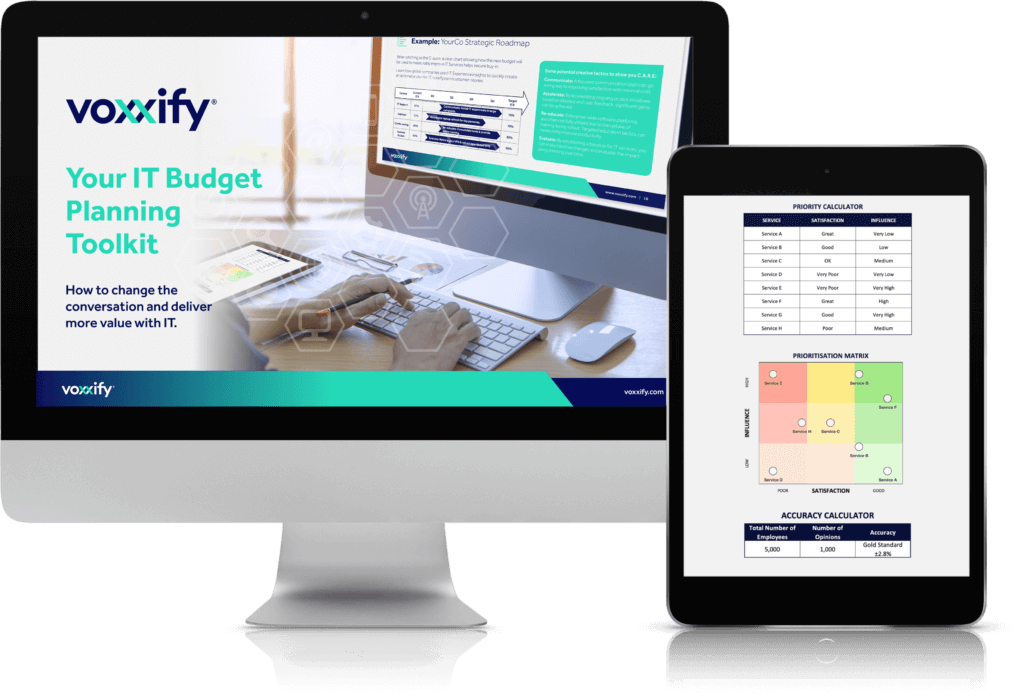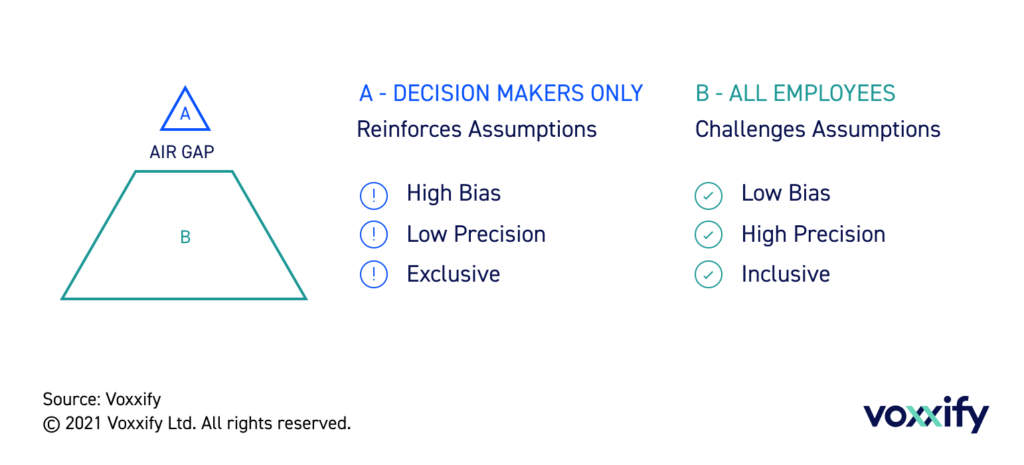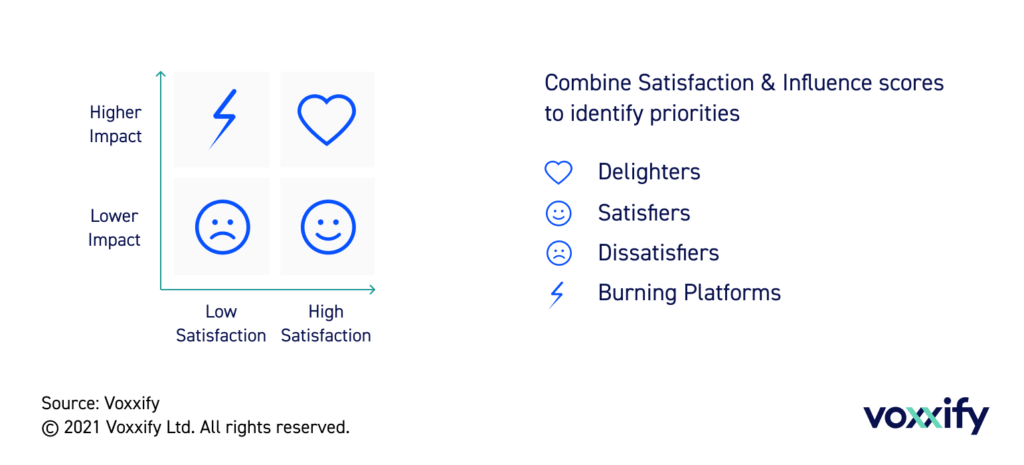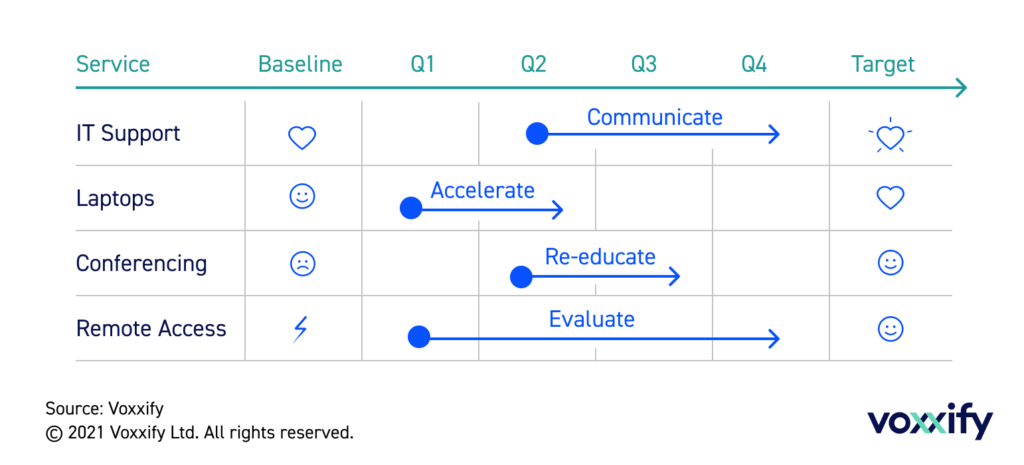
Change the Conversation to get Buy-in.
Digital transformation, hybrid working and cybersecurity goals all demand incremental spend, putting budgets under extra pressure. During the budget planning process this can lead to friction between the CIO and CFO.
By putting IT Experience data at the center of your plan, presented in terms that resonate with the business, CIOs can get on the same page as Finance and unlock the investment they need.
Voxxify’s IT Budget Planning Toolkit gives you the tools and data you need to change the conversation and secure buy-in from the business.

Gather data the business can trust
To fully assess the business impact of IT spend you need more than system data and financial metrics. The missing metric in most IT budget discussions is Employee Experience.
Traditionally IT Support tickets have been used as a proxy for experience metrics, combined with anecdotal data from a small number of experts. This data can suffer from bias, and may not be precise or specific enough to show trends in a way that the business can trust.
A better way is to get quality feedback on IT satisfaction from as many end users as possible. This will add valuable context to existing business & IT metrics, giving decision-makers a comprehensive view of the business impact of IT, in a way that is specific, trendable and reliable.

Pro Tip: Imperfect data is better than no data at all
If you don’t have access to a comprehensive, IT-specific surveying tool like Voxxify, you can estimate end-user sentiment using our handy calculator in the IT Budget Planning Toolkit. Estimates based on a small sample size may not be statistically reliable, but they will get you started on the journey to business aligned IT.
Prioritize what matters most to the business
Once you have identified what is or isn’t performing well from the end user perspective (Satisfaction), the next step is to understand what people care most about (Influence), and what needs to be prioritized for further investment, or even where savings can be made.
This is where it gets interesting! Plotting Satisfaction vs Influence for your key IT services will allow you to fully visualize priorities in a way that makes decisions a lot easier, highlighting:

- Burning Platforms: Poorly performing IT services in the Top Left quadrant are having the greatest negative business impact and need urgent attention.
- Delighters: Top right services should be celebrated & rewarded within IT, and communicated across the business to show how IT is exceeds expectations.
- Low Hanging Fruit: a small nudge to IT Services in the lower row of the grid may be all that is needed. Education & communication can bring outsized returns.
By bringing this comprehensive, segmented and crystal clear approach, informed by reliable data from within the business, you will build more trust and credibility for your plan.
Pro Tip: The best time to start prioritizing is now
If you don’t have access to a comprehensive data set with powerful analytics to generate statistically-reliable insights, you can generate a Voxxify-style X-Grid using our handy calculator in the IT Budget Planning Toolkit. This will help you move the conversation away from reducing costs towards showing the business value that IT can provide.
Show that you C.A.R.E
With reliable data, prioritized appropriately, you will have almost everything you need for your business-aligned investment pitch. Next step is to secure buy-in with a compelling roadmap that will get the attention of key decision-makers.
Get everyone on the same page by speaking the language of the business and framing your pitch around opportunities and business value, rather than problems and IT cost. People get more excited about where you can take them than where they have just been. Once you have alignment on where you are going, and why, you are ready to engage with the CFO.

Below are 3 key principles to keep in mind when engaging with the CFO during budget time:
- Keep it Simple: Avoid information overload by keeping the message simple, and jargon-free.
- Be Creative: Help the CFO find budget for new initiatives by offering up potential savings.
- Do your Research: bring good data from the field to support your pitch.
Remember to Communicate, Communicate, Communicate! Continuous engagement with the CFO throughout the budget planning process will build trust. Be transparent.
With this three step approach you are truly changing the conversation for the better!
Pro Tip: Create a Visual, Business Focused IT Roadmap:
Providing a high level executive summary with a visual, business-focussed roadmap will accelerate buy-in. Communicate in business terms, not technology terms, and put people at the center. Check out our IT Budget Planning Toolkit for examples and templates.
Gather data the business can trust
To fully assess the business impact of IT spend you need more than system data and financial metrics. The missing metric in most IT budget discussions is Employee Experience.
Traditionally IT Support tickets have been used as a proxy for experience metrics, combined with anecdotal data from a small number of experts. This data can suffer from bias, and may not be precise or specific enough to show trends in a way that the business can trust.
A better way is to get quality feedback on IT satisfaction from as many end users as possible. This will add valuable context to existing business & IT metrics, giving decision-makers a comprehensive view of the business impact of IT, in a way that is specific, trendable and reliable.

Pro Tip: Imperfect data is better than no data at all
If you don’t have access to a comprehensive, IT-specific surveying tool like Voxxify, you can estimate end-user sentiment using our handy calculator in the IT Budget Planning Toolkit. Estimates based on a small sample size may not be statistically reliable, but they will get you started on the journey to business aligned IT.
Prioritize what matters most to the business
Once you have identified what is or isn’t performing well from the end user perspective (Satisfaction), the next step is to understand what people care most about (Influence), and what needs to be prioritized for further investment, or even where savings can be made.
This is where it gets interesting! Plotting Satisfaction vs Influence for your key IT services will allow you to fully visualize priorities in a way that makes decisions a lot easier, highlighting:

- Burning Platforms: Poorly performing IT services in the Top Left quadrant are having the greatest negative business impact and need urgent attention.
- Delighters: Top right services should be celebrated & rewarded within IT, and communicated across the business to show how IT is exceeds expectations.
- Low Hanging Fruit: a small nudge to IT Services in the lower row of the grid may be all that is needed. Education & communication can bring outsized returns.
By bringing this comprehensive, segmented and crystal clear approach, informed by reliable data from within the business, you will build more trust and credibility for your plan.
Pro Tip: The best time to start prioritizing is now
If you don’t have access to a comprehensive data set with powerful analytics to generate statistically-reliable insights, you can generate a Voxxify-style X-Grid using our handy calculator in the IT Budget Planning Toolkit. This will help you move the conversation away from reducing costs towards showing the business value that IT can provide.
Show that you C.A.R.E
With reliable data, prioritized appropriately, you will have almost everything you need for your business-aligned investment pitch. Next step is to secure buy-in with a compelling roadmap that will get the attention of key decision-makers.
Get everyone on the same page by speaking the language of the business and framing your pitch around opportunities and business value, rather than problems and IT cost. People get more excited about where you can take them than where they have just been. Once you have alignment on where you are going, and why, you are ready to engage with the CFO.

Below are 3 key principles to keep in mind when engaging with the CFO during budget time:
- Keep it Simple: Avoid information overload by keeping the message simple, and jargon-free.
- Be Creative: Help the CFO find budget for new initiatives by offering up potential savings.
- Do your Research: bring good data from the field to support your pitch.
Remember to Communicate, Communicate, Communicate! Continuous engagement with the CFO throughout the budget planning process will build trust. Be transparent.
With this three step approach you are truly changing the conversation for the better!
Pro Tip: Create a Visual, Business Focused IT Roadmap:
Providing a high level executive summary with a visual, business-focussed roadmap will accelerate buy-in. Communicate in business terms, not technology terms, and put people at the center. Check out our IT Budget Planning Toolkit for examples and templates.
FAQs: Planning with IT Experience
Because people matter. Your business or organisation is only as good as the people who work there, and unless those people are provided with the tools and services they need, they won’t be effective or productive. Organisation that don’t actively measure this IT Experience, can struggle to manage it effectively.
Quarterly is generally considered to be best, but this depends on various factors such as size of your organization as well as your ability to introduce change quickly in response to feedback. Of course the quality of your survey tool can be a significant factor too.
- Size – Larger organizations can survey more frequently than smaller ones, as each survey round can be sent to a sample of the population, rather than everyone in the organization. This avoids what is commonly known as survey fatigue.
- Agility – Ensure you match the pace of surveying with your ability to introduce change quickly, and that you communicate effectively to show the feedback is being taken on board. Once you start surveying, your employees will expect you to do something with the results.
- Survey tool – When surveys are designed in-house using generic survey platforms it is typically extremely difficult to achieve a high response rate. Choosing a fit for purpose survey tool like Voxxify will ensure maximum survey quality, with minimal survey fatigue.
- Focus on your top 10-12 IT services to get started. As you discover hotspots you can go deeper.
- Ask about capabilities rather than technologies. The business cares less about the tools than what they can do with them.
- Ensure the questions are employee focussed – they need to know you care about them and their situation.
- Survey every part of the organization, including IT. You need comprehensive feedback to ensure all groups are represented.
- Before you define your audience ask your team: Who is most impacted by our service? Where might problems go unreported?
If you haven’t gathered comprehensive IT Experience metric before, you can get started by downloading our IT Budget Planning Toolkit. It provides practical frameworks and a simple IT Experience Calculator you can use to ground your IT action plan in business terms, focused on the needs of end users across your organization.
At Voxxify we are passionate about helping people use the “Missing Metric” of IT Experience to transform how decisions are made and how success is measured.
If you’re interested in learning more you can book 30 minutes with one of our IT Experience advisors who has 30 years of experience in this area: Book a Call.